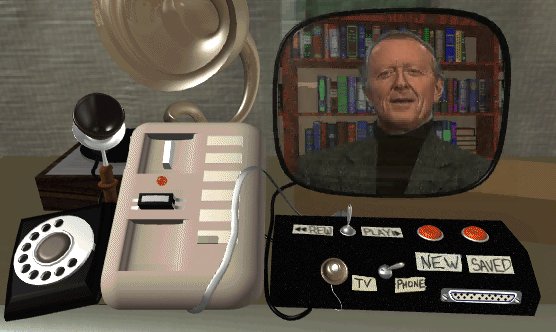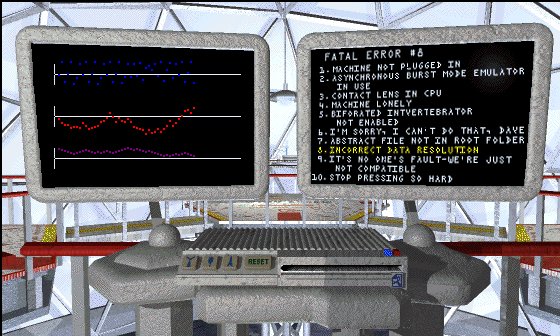 Chaos: A Fantasy Adventure Game was made in 1996, by New York University. It is an FMV game, based on the science of chaos theory, and…
Chaos: A Fantasy Adventure Game was made in 1996, by New York University. It is an FMV game, based on the science of chaos theory, and…
Why didn’t my university let me make a videogame for a senior project? That’s what this game feels like. It feels like three college students—a science major, a theater major and a computer programming major—all got together to make a videogame. As a result, this game is 50% pure enthusiasm, from people who are having fun making something great. Sadly, the game is also 50% drek, from amateurs who have no idea how to make a professional-quality videogame.
Let’s talk about the positive things first. The FMV sections are extremely well done. Why? The game comes from NYU’s Theater Department. That means all of the actors in the game are legitimate actors, who starred in Oscar-nominated movies like The Shawshank Redemption and Dead Man Walking. IMDB tells me that most of these actors still have active careers today, seventeen years later. That’s pretty impressive for an FMV game.
In comparison, try using IMDB to look up the actors in the Sherlock Holmes FMV game. Their careers started and ended with that game.
Another plus for the game is the humor. This game is extremely funny. The actors deliver hilarious performances, to the point that I sometimes quote jokes from this game, to the confusion of everyone around me. There’s a decent variety of humor, as well, and I’m glad that the game hasn’t dated itself by using 1990’s pop culture references. The last time I played the game, though, I didn’t find it as funny as I did when I was younger. I guess some of the jokes lose their flavor when you stop being a college student and start being a productive member of society.
The final good thing about the game are the graphics. The game comes in 256 glorious colors. You can’t beat that!
 “Doctor, the patient has a serious case of green screen! Can you help?”
“Doctor, the patient has a serious case of green screen! Can you help?”
Now for the bad things about the game: the puzzles. Oh, the puzzles. This game features some textbook examples of bad adventure game puzzles. These include…
- Puzzle where it’s unclear what you have to do. To make matters worse, the game doesn’t tell you when you’ve successfully solved the puzzle.
- Puzzle whose solution depends on an extremely minor/obscure thing. There are a couple of these. The worst offender is the one where you have to read a particular sentence, hidden in the middle of a twelve-page document.
- Repetitive puzzle. The coastline puzzle requires you to do the same thing fifteen times in a row. They should have stopped at seven.
- The dreadful maze puzzle. The game gives you a map which doesn’t match the maze in some places. It’s impossible to tell where you are, in the maze, because they reuse graphics at several points. Finally, the pathways in the maze are inconsistent. Usually, clicking the forward arrow takes you forward, but sometimes, it takes you to the left. What?
- The dreadful maze puzzle. Yes, I’m listing this puzzle again. With most maze puzzles, your goal is to get to the end of the maze. With this maze puzzle, your goal is to visit every single screen of the maze. That includes going to the same location, from multiple angles.
- The randomized puzzle. The game has a stock market puzzle, which runs on randomized prices. I guess it’s realistic to have the stock market fluctuate randomly, but it ruins the puzzle because the game never shows you what the prices are. So one second, your stock is worth $50, and another second it’s worth $500, and you have no way of knowing what the stock price is when you buy or sell.
There are a few solid puzzles, like the weather station puzzle, but the bad puzzles outnumber the good puzzles. It’s kind of sad, because the some of the bad puzzles could easily be improved.

It’s not every day that you see a video phone with a rotary dial.
I suppose I should finish off with the educational material. Chaos is an educational game based on chaos theory. Sometimes, you can easily see the connection between the game and the source material. For example, the coastline driving puzzle is based on the mathematics paper How Long Is the Coast of Britain? Statistical Self-Similarity and Fractional Dimension, while a fractal known as the Barnsley Fern results in a botany puzzle.
Other times, the game fudges things a bit. For example, the weather and the stock market get a free pass as “educational chaos theory material”, simply because they’re hard to predict. Same with a music puzzle, because…uh…predicting what song will be #1 on the charts is hard. There’s also a heart surgery puzzle which is included because…um…there are fractals in the human body?
Each section of the game is paired with a short video, which explains how it is related to chaos theory. These videos are actually rather interesting, but they’re completely optional. As a result, you can easily go through the entire game without learning a single thing about chaos theory, besides for the fact that it’s weird, complicated and confusing.
Should the game developers be blamed, for not making this game as educational as possible? Probably not. I think the game developers did the best with what they could. Higher level mathematics does not easily translate into adventure game puzzles. If I had to hold something against the educational content of the game, it would be the fact that a butterfly appears in three separate scenes, but they specifically avoid mentioning the butterfly effect. What’s the point of including the butterfly effect in an educational game if you won’t talk about it?
As I said at the beginning, this game feels like it was made by three college students, working together on a senior project. I’d give an A to the theater student, and a B to the science student. For the computer programmer, he’d get an A for programming the game well, but a C or a D for puzzle execution.
If they complained about their grades, I’d say that grades are chaotic and unpredictable in nature. That’s chaos theory for you.


